|

 Up
Up

 The Hearst
The Hearst
Prize

(You are here.)
 Down
Down




  Need
to Need
to
find your
bearings?
Try
these
navigation aids:
If
this is your first
visit, please stop by:
Something
to share?
Please:



|
|
Available in Française, Español, Português, Deutsch, Россию,
中文,
日本, and others.
 t's
important because everything else I've done is unimportant," was a
nice sound bite, but it wasn't the whole story. Cal Rodgers was in
Long Island preparing to fly across America because of William
Randolf Hearst. In
October of 1910 Hearst, the owner and publisher of the largest chain of
newspapers and magazines in the world, sought to further the
cause of aviation and boost the circulation of his newspapers (not
necessarily in that order). He offered $50,000 to the first
aviator to cross the United States in an airplane in under 30 days.
Experts had warned him that because aviation was in its infancy and the
primitive airplanes were fragile and unreliable, this was an absurd notion that would
bring nothing but ridicule. Hearst ignored them and went forward with the
offer. He was lauded for his vision and genius, and was awarded a medal
from the Aeronautical Society of America. t's
important because everything else I've done is unimportant," was a
nice sound bite, but it wasn't the whole story. Cal Rodgers was in
Long Island preparing to fly across America because of William
Randolf Hearst. In
October of 1910 Hearst, the owner and publisher of the largest chain of
newspapers and magazines in the world, sought to further the
cause of aviation and boost the circulation of his newspapers (not
necessarily in that order). He offered $50,000 to the first
aviator to cross the United States in an airplane in under 30 days.
Experts had warned him that because aviation was in its infancy and the
primitive airplanes were fragile and unreliable, this was an absurd notion that would
bring nothing but ridicule. Hearst ignored them and went forward with the
offer. He was lauded for his vision and genius, and was awarded a medal
from the Aeronautical Society of America.
Several aviators announced their intentions to try for the prize, but
only three made it to the starting line — Robert Fowler, Jimmy Ward, and
Calbraith Perry Rodgers. Of these, Cal Rodgers was the last off the mark,
leaving Sheepshead Bay on Long Island, New York late in the afternoon of
17 September 1911, just
a few weeks before the Hearst offer was due to expire.
The Hearst prize, if Cal won it, would only partially pay for the trip.
Rodgers not only needed an airplane but whole support crew to follow him
across America. That crew chased him in a private train leased by Cal.
The train included a passenger car and a "hangar car" that carried Cal's
Wright Model B, an automobile, and enough spare parts to
completely rebuild the Vin Fiz.
To finance this adventure, Stewart DeKrafft secured financial backing from the Armour Meat-Packing Company.
They agreed to pay Cal $5 for every mile he flew east of the
Mississippi River and $4 for every mile west of the river, where the
land was less populated. They planned to use the publicity generated
by the transcontinental flight to promote a new grape-flavored soft drink, "Vin Fiz." Consequently,
Cal's aircraft was christened the Vin Fiz and the chase train
became the Vin Fiz Special. Armour painted the Vin Fiz logo
everywhere, including the underside of the aircraft wings. Cal even
lashed a bottle of Vin Fiz to a front strut. Privately, he called the airplane
"Betsy" and regarded the bottle as a powerful totem.
For additional income, Cal planned to do exhibition flights wherever
Dekrafft could make the arrangements enroute. He would also take
passengers aloft for a fee in his Model B. Even Cal's wife, Mabel Graves
Rodgers, contributed to the cause by arranging a semi-official airmail
service with the U.S. Post Office and selling Vin Fiz postcards
and stamps. And so, flush with aircraft parts, chase vehicles,
prospects and possibilities, Cal Rodgers had his mechanics swing the
props and started the engine of the Vin Fiz. He let the
engine warm for a few moments, stuck his cigar in his mouth, and
took off across America.
|

William Randolf Hearst. During a circulation war with Joseph
Pulitzer, Hearst spawned "yellow journalism"
– sensational stories that
stretched the truth.
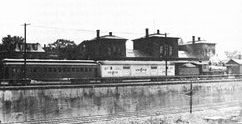
he Vin Fiz Special carried
enough spare parts aboard a special "hangar car" to build a second
Wright Model EX. Rodgers needed almost every single one.
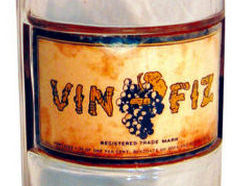
A bottle Vin Fiz
syrup, used by soda fountains to make
Vin Fiz soda. One newspaper along the route reviewed the drink
and pronounced it "a fine blend of river water and horse slop."

As he flew, Cal Rodgers dutifully scattered 3" by
4" bright yellow advertising leaflets to the crowds that gathered to watch him.
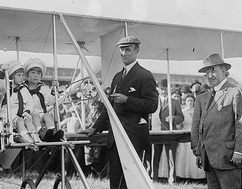
Cal Rodgers (middle) with Vin Fiz Bottling Co. President
Charles Davidson (right) at the initial take-off ceremonies.
|
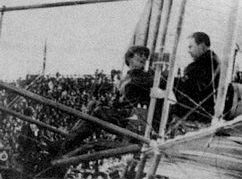
Publisher Hearst flies at the San Diego Air Meet in 1910 after pilot Louis Paulhan invited him to "buss the clouds."

Pilot Cal Rodgers and promoter Stewart Dekrafft beside the
Vin Fiz.
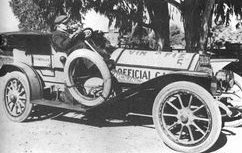
The hangar car also carried a Palmer-Singer
automobile. Whenever
Cal would go down, the train would stop and the crew would unload the
auto to look for him.
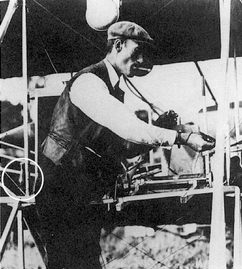
Although his crew agreed "you had to
sneak up on the stuff to get it down," Cal flew
with a bottle of Vin Fiz
(circled) and regarded it as a good luck charm.
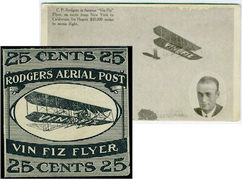
The Vin Fiz postcard and
semi-official air mail stamp.
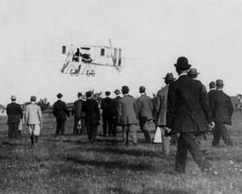
The Vin Fiz takes off from Sheepshead Bay,
New York on 17 September 1911.
|